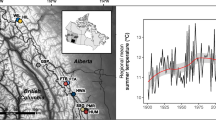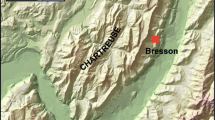Abstract
Key message
Layering plays a major role in treeline stability. Growth ring pattern of clonal groups reflects both an individualistic and an only temporally common response to the harsh treeline environment.
Abstract
Clonal groups are common to alpine and polar treelines. Distribution, shape, architecture, and development of clonal Picea engelmannii and Abies lasiocarpa in an extremely windy Rocky Mountain treeline ecotone are considered. Clonal groups prevail (>70% of all tree groups). Most of them consist of A. lasiocarpa (65%). Number, growth form, and damage were documented along transects and field routes. Age structure and development of the clonal groups were assessed using increment cores and stem disks. The groups usually consisted of different clonal series with several clonal members in each. On wind-swept terrain, clonal groups exhibit wedge-like, hedge-like, or mat-like habit. One clonal A. lasiocarpa group was studied in detail and it serves as an example showing formation, architecture, and internal growth pattern of clonal series. The clone members in the clone series exhibited an individualistic growth pattern. Wind-control of growth occasionally overruled the often ‘chaotic’ internal group growth pattern. The effect of prevailing winds, however, temporally overlapped with a ‘force’ directed from the center of the group margin (e.g., competition for light, high stem density), as reflected in recurrent change of eccentricity within the clonal trunks. Clonal groups may be of major importance in treeline dynamics.


(modified from Holtmeier 1978; Holtmeier and Broll 2010). The inset (upper left) shows the geographical position of the Colorado Front Range. The inset (middle left) shows mean wind directions (% of total wind data) at 500 hPa level. Airflow directions were taken from the daily high-level weather maps (1958–1974). The box at the right hand side indicates the location of the study site on Niwot Ridge









Modified from Holtmeier 1999

Modified from Holtmeier 1999

Similar content being viewed by others
References
Arno SF (1984) Timberlines, mountain and arctic frontier. The Mountaineers, Seattle
Arno SF, Habeck JR (1972) Ecology of alpine larch (Larix lyallii Parl.) in the Pacific Northwest. Ecol Monogr 42:417–450
Barry RG (1973) A climatological transect along the east slope of the Front Range, Colorado. Arctic Alpine Res 5:89–110
Bekker MF, Malanson GP (2008) Linear forest patterns in subalpine environments. Prog Phys Geog 32:635–653
Benedict JM (1984) Rates of tree-island migration, Colorado Rocky Mountains. Ecology 65:820–823
Broll G, Holtmeier F-K (1994) Die Entwicklung von Kleinreliefstrukturen im Waldgrenzökoton der Front Range (Colorado, USA) unter dem Einfluß leewärts wandernder Ablegergruppen (Picea engelmannii and Abies lasiocarpa). Erdkunde 48(1):48–59
Caccianiga M, Payette S (2006) Recent advance of white spruce (Picea glauca) in the coastal tundra of the eastern shore of Hudson Bay (Québec, Canada). J Biogeogr 33:2120–2135
Caine N (1996) Streamflow patterns in the alpine environment of North Boulder Creek, Colorado Front Range. Z Geomorphol 104:27–42
Cooper WS (1931) The layering habit in Sitka spruce and the two western hemlocks. Bot Gaz 91:441–451
Daly C, Shankman D (1985) Seedling establishment by conifers above tree limit on Niwot Ridge, Front Range, Colorado, USA. Arctic Alpine Res 17(4):389–400
Elliott D (1979) The current regeneration capacity of the northern Canadian trees, Keewatin, N.W.T., Canada: some preliminary observations. Arctic Alpine Res 11(2):243–251
Fanta J (1971) Fagus sylvatica L. und das Aceri-Fagetum an der alpinen Waldgrenze in mitteleuropäischen Gebirgen. Vegetatio 44:13–14
Fanta J. (1973) Die vegetative Vermehrung der Fichte in der Lüneburger Heide. Mitteilung der Deutschen Dendrologischen Gesellschaft 66:39–48
Fink S (1980) Anatomische Untersuchungen über das Vorkommen von Sproß- und Wurzelanlagen im Stammbereich von Laub- und Nadelbäumen. Dissertation, University of Freiburg/Br
Grafius DR, Malanson GP (2015) Biomass distribution in dwarf tree, krummholz, and tundra vegetation in the alpine treeline ecotone. Phys Geogr. doi:10.1080/02723646.2015.1050954
Hanisch B (1983) Analyse des naturnahen Fichtenwaldes im norwegischen Nationalpark Ormtjernkampen Villmark. Schriftenreihe des Waldbau-Instituts der Albert-Ludwigs-Universität Freiburg i. Br., Volume 1
Hansen-Bristow KJ, Ives JD (1985) Composition, form, and distribution of the forest-alpine tundra ecotone, Indian Peaks, Colorado, USA. Erdkunde 39:286–295
Holtmeier F-K (1978) Die bodennahen Winde in den Hochlagen der Indian Peaks Section (Colorado Front Range). Münstersche Geographische Arbeiten 3:5–47
Holtmeier F-K (1986) Über Bauminseln (Kollektive) an der klimatischen Waldgrenze—unter besonderer Berücksichtigung von Beobachtungen in verschiedenen Hochgebirgen Nordamerikas. Wetter Leben 38:121–129
Holtmeier F-K (1987) Der Baumwuchs als klimaökologischer Faktor an der oberen Waldgrenze. Münstersche Geographische Arbeiten 27:145–151
Holtmeier F-K (1993) Der Einfluß der generativen und vegetativen Vermehrung auf das Verbreitungsmuster der Bäume und die ökologische Dynamik im Waldgrenzbereich. Beobachtungen und Untersuchungen in Hochgebirgen Nordamerikas und in den Alpen. Geoökodynamik 14:153–182
Holtmeier F-K (1996) Der Wind als landschaftsökologischer Faktor in der subalpinen und alpinen Stufe der Front Range, Colorado. Arbeiten aus dem Institut für Landschaftsökologie, Westfälische Wilhelms-Universität Münster 1:19–45
Holtmeier F-K (1999) Ablegerbildung im Hochlagenwald und an der oberen Waldgrenze in der Front Range, Colorado. Mitteilungen der Deutschen Dendrologischen Gesellschaft 84:39–61
Holtmeier F-K (2009) Mountain timberlines. Ecology, patchiness, and dynamics (2nd edition). Advances in global change research 36. Science + Media B. V., Dordrecht
Holtmeier F-K, Broll G (1992) The influence of tree islands and microtopography on pedoecological conditions in the forest-alpine tundra ecotone on Niwot Ridge, Colorado Front Range, USA. Arctic Alpine Res 24(3):216–228
Holtmeier F-K, Broll G (2010) Wind as an ecological agent at treelines in North America, the Alps, and the European Subarctic. Phys Geogr 31(3):203–233
Kihlman AO (1890) Pflanzenbiologische Studien aus Russisch-Lappland. Acta Societatis pro Fauna et Flora Fennica 6(3):261 pp
Kontic R, Niederer M, Nippel CA, Winkler-Seifert A (1986) Jahrringanalysen an Nadelbäumen zur Darstellung und Interpretation von Waldschäden (Wallis, Schweiz). Eidgenössische Anstalt für das forstliche Versuchswesen Bericht 238:46 pp
Kullman L (2012) The alpine treeline ecotone in the southwestern Swedish Scandes: Dynamics on different scales. In: Myster RW (ed) Ecotones between forest and grassland. Springer Science + Business Media, New York, pp 271–298
Kuoch R, Amiet R (1970) Die Verjüngung im Bereich der oberen Waldgrenze der Alpen. Mitteilungen der schweizerischen Anstalt für das forstliche Versuchswesen 46:159–328
Laberge M-J, Payette S, Bousquet J (2000) Life span and biomass allocation of stunted black spruce clones in the subarctic environment. J Ecol 88:584–593
Larcher W (1980) Klimastreß im Gebirge—Adaptionstraining und Selektionsfilter für Pflanzen. Rheinisch-Westfälische Akademie der Wissenschaften, Vorträge, vol 291, pp 49–80
Litaor MI, Willimas M, Seastedt TR (2008) Topographical controls on snow distribution, soil moisture, and species diversity of herbaceous vegetation, Niwot Ridge, Colorado. J Geophys Res 113(3). doi:10.1029/2007J6000419
Marr JW (1967) Ecosystems on the east slope of the Front Range of Colorado. Univ Colo Stud Ser Biol 8
Marr JW (1977) The development and movement of tree islands near the upper limit of tree growth on the southern Rocky Mountains. Ecology 58:1159–1164
Mczkowski S (1972) Structure and ecology of the spruce association Piceetum tatricum of the upper limit of its distribution in Tatra National Park. Academy of Agriculture, Forest Faculty, Cracow
Mitton JB (1985) So grows the tree. Nat Hist 1:58–65
Nordfors GA (1921) Något om den vegetative föryngringen I våra skkogar med särskild hänsyn till franens föryngring i fjällskog. Norrlands Sogvårdsforbuns Tidskrift 1
Öberg L, Kullman L (2011) Ancient subalpine clonal spruces (Picea abies): sources of postglacial vegetation history in the Swedish Scandes. Arctic 64:183–196
Payette S (1976) Succession écologique des forêts d’épinette blanche et fluctuations climatiques, Poste-de-la-Baleine, Nouveau Québec. Can J Bot 54:1394–1402
Payette S, Moreneau C (1993) Holocene relict woodland at the eastern Canadian treeline. Quaternary Res 39:84–89
Payette S, Delwaide A, Moreneau C, Lavoie C (1994) Stem analysis of a long-lived black spruce close at timberline. Arct Antarct Alp Res 26(1):56–59
Ragonezi C, Klimaszewska K, Castro MR, Lima M, de Oliveira P, Zavattieri MA (2010) Adventitious rooting of conifers: influence of physical and chemical factors. Trees 24:975–992
Schmidt-Vogt H (1991) Die Fichte, Band II/3. Verlag Paul Parey, Hamburg
Schönenberger W (1978) Ökologie der natürlichen Verjüngung der Fichte und Bergföhre in Lawinenzügen der nördlichen Voralpen. Mitteilungen der Eidgenössischen Anstalt für das forstliche Versuchswesen 54(3) 215–361
Schönenberger W (1981) Die Wuchsformen der Bäume an der alpinen Waldgrenze. Schweizerische Zeitschrift für Forstwesen 13(3):149–162
Schweingruber FH (1983) Der Jahrring. Standort, Methodik, Zeit und Klima in der Dendrochronologie. Bern
Schweingruber FK, Albrecht H, Beck M, Hessel J, Joos K, Keller D, Kontic R, Lange K, Niederer M, Nippel C, Spang S, Spinnler A, Steiner B, Winkler-Seifert A (1986) Abrupte Zuwachsschwankungen in Jahrringabfolgen als ökologische Indikatoren. Dendrochronologia 4:125–138
Šenfeldr M, Urban J, Madĕra P, Kučera J (2016) Redistribution of water via layering branches between connected parent and daughter trees in Norway spruce clonal groups. Trees 30:5–17
Stimm B (1985) Untersuchungen über Ablegerbildung und sproßbürtige Bewurzelung der Fichte (Picea abies (L.) Karst. Dissertation, Forstwissenschaftliche Fakultät, University of München
Stimm B (1987) Morphologisch-anatomische Untersuchungen zur Ablegerbildung und sproßbürtigen Bewurzelung der Fichte (Picea abies (L.) Karst. Flora 179:421–443
Stokes MA, Smiley TL (1968) An introduction to tree ring dating. Chicago
Vacek S, Hejcmanová M, Hejcman M (2012) Vegetative reproduction of Picea abies by artificial layering at the ecotone of the alpine timberline in the Giant (Krkonoše) Mountains, Czech Republic. For Ecol Manag 263:199–207
Wardle P (1968) Engelmann spruce (Picea engelmannii Engel.) at its upper limits on the Front Range, Colorado. Ecology 49:483–495
Zimmermann MH, Brown CL (eds) (1971) Trees–structure and function. Springer, Berlin
Acknowledgements
Our thanks go to Prof. Robert M. M. Crawford (University of St. Andrews, Scotland) for revising the manuscript.
Author information
Authors and Affiliations
Corresponding author
Additional information
Communicated by A. Bräuning.
Rights and permissions
About this article
Cite this article
Holtmeier, FK., Broll, G. Layering in the Rocky Mountain treeline ecotone: clonal conifer groups’ distribution, structure, and functional role. Trees 31, 953–965 (2017). https://doi.org/10.1007/s00468-017-1520-z
Received:
Accepted:
Published:
Issue Date:
DOI: https://doi.org/10.1007/s00468-017-1520-z




